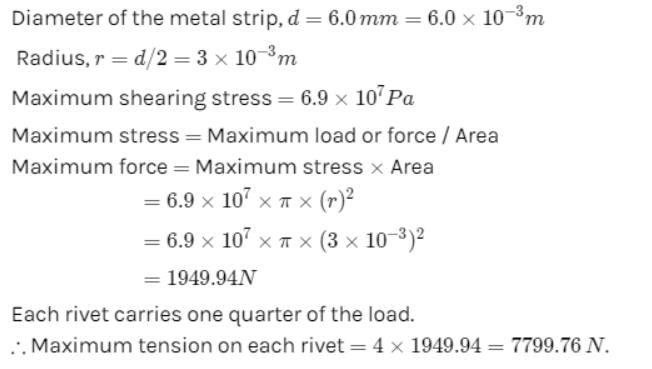Class 11 Exam > Class 11 Questions > Two strips of metal are riveted together at t...
Start Learning for Free
Two strips of metal are riveted together at their ends by four rivets, each of diameter 6.0 mm. What is the maximum tension that can be exerted by the riveted strip if the shearing stress on the rivet is not to exceed 6.9 × 107Pa? Assume that each rivet is to carry one quarter of the load.
- a)749 kN
- b)856 kN
- c)652 N
- d)None of these
Correct answer is option 'D'. Can you explain this answer?
Verified Answer
Two strips of metal are riveted together at their ends by four rivets,...

Most Upvoted Answer
Two strips of metal are riveted together at their ends by four rivets,...
To find the maximum tension that can be exerted by the riveted strip, we need to calculate the maximum shearing force that each rivet can withstand.
The shearing stress on the rivet can be calculated using the formula:
shearing stress = force / area
We know that the diameter of each rivet is 6.0 mm, so the radius (r) is 6.0 mm / 2 = 3.0 mm = 0.003 m.
The area of each rivet can be calculated using the formula:
area = π * r^2
Substituting the value of r, we get:
area = π * (0.003 m)^2
Calculating the area, we find:
area = 0.00002827 m^2
The shearing stress on each rivet is given as 6.9 MPa. To convert this to Pascals, we multiply by 10^6:
shearing stress = 6.9 MPa * 10^6
Calculating the shearing stress, we find:
shearing stress = 6,900,000 Pa
Now, we can calculate the maximum force that each rivet can withstand by rearranging the formula:
force = shearing stress * area
Substituting the values we've calculated, we get:
force = 6,900,000 Pa * 0.00002827 m^2
Calculating the force, we find:
force = 194.763 N
Since there are four rivets, the maximum tension that can be exerted by the riveted strip is:
maximum tension = 4 * 194.763 N
Calculating the maximum tension, we find:
maximum tension = 779.052 N
Therefore, the maximum tension that can be exerted by the riveted strip is approximately 779.052 Newtons.
The shearing stress on the rivet can be calculated using the formula:
shearing stress = force / area
We know that the diameter of each rivet is 6.0 mm, so the radius (r) is 6.0 mm / 2 = 3.0 mm = 0.003 m.
The area of each rivet can be calculated using the formula:
area = π * r^2
Substituting the value of r, we get:
area = π * (0.003 m)^2
Calculating the area, we find:
area = 0.00002827 m^2
The shearing stress on each rivet is given as 6.9 MPa. To convert this to Pascals, we multiply by 10^6:
shearing stress = 6.9 MPa * 10^6
Calculating the shearing stress, we find:
shearing stress = 6,900,000 Pa
Now, we can calculate the maximum force that each rivet can withstand by rearranging the formula:
force = shearing stress * area
Substituting the values we've calculated, we get:
force = 6,900,000 Pa * 0.00002827 m^2
Calculating the force, we find:
force = 194.763 N
Since there are four rivets, the maximum tension that can be exerted by the riveted strip is:
maximum tension = 4 * 194.763 N
Calculating the maximum tension, we find:
maximum tension = 779.052 N
Therefore, the maximum tension that can be exerted by the riveted strip is approximately 779.052 Newtons.
Free Test
FREE
| Start Free Test |
Community Answer
Two strips of metal are riveted together at their ends by four rivets,...
D is correct.

|
Explore Courses for Class 11 exam
|

|
Question Description
Two strips of metal are riveted together at their ends by four rivets, each of diameter 6.0 mm. What is the maximum tension that can be exerted by the riveted strip if the shearing stress on the rivet is not to exceed 6.9 × 107Pa? Assume that each rivet is to carry one quarter of the load.a)749kNb)856kNc)652 Nd)None of theseCorrect answer is option 'D'. Can you explain this answer? for Class 11 2025 is part of Class 11 preparation. The Question and answers have been prepared according to the Class 11 exam syllabus. Information about Two strips of metal are riveted together at their ends by four rivets, each of diameter 6.0 mm. What is the maximum tension that can be exerted by the riveted strip if the shearing stress on the rivet is not to exceed 6.9 × 107Pa? Assume that each rivet is to carry one quarter of the load.a)749kNb)856kNc)652 Nd)None of theseCorrect answer is option 'D'. Can you explain this answer? covers all topics & solutions for Class 11 2025 Exam. Find important definitions, questions, meanings, examples, exercises and tests below for Two strips of metal are riveted together at their ends by four rivets, each of diameter 6.0 mm. What is the maximum tension that can be exerted by the riveted strip if the shearing stress on the rivet is not to exceed 6.9 × 107Pa? Assume that each rivet is to carry one quarter of the load.a)749kNb)856kNc)652 Nd)None of theseCorrect answer is option 'D'. Can you explain this answer?.
Two strips of metal are riveted together at their ends by four rivets, each of diameter 6.0 mm. What is the maximum tension that can be exerted by the riveted strip if the shearing stress on the rivet is not to exceed 6.9 × 107Pa? Assume that each rivet is to carry one quarter of the load.a)749kNb)856kNc)652 Nd)None of theseCorrect answer is option 'D'. Can you explain this answer? for Class 11 2025 is part of Class 11 preparation. The Question and answers have been prepared according to the Class 11 exam syllabus. Information about Two strips of metal are riveted together at their ends by four rivets, each of diameter 6.0 mm. What is the maximum tension that can be exerted by the riveted strip if the shearing stress on the rivet is not to exceed 6.9 × 107Pa? Assume that each rivet is to carry one quarter of the load.a)749kNb)856kNc)652 Nd)None of theseCorrect answer is option 'D'. Can you explain this answer? covers all topics & solutions for Class 11 2025 Exam. Find important definitions, questions, meanings, examples, exercises and tests below for Two strips of metal are riveted together at their ends by four rivets, each of diameter 6.0 mm. What is the maximum tension that can be exerted by the riveted strip if the shearing stress on the rivet is not to exceed 6.9 × 107Pa? Assume that each rivet is to carry one quarter of the load.a)749kNb)856kNc)652 Nd)None of theseCorrect answer is option 'D'. Can you explain this answer?.
Solutions for Two strips of metal are riveted together at their ends by four rivets, each of diameter 6.0 mm. What is the maximum tension that can be exerted by the riveted strip if the shearing stress on the rivet is not to exceed 6.9 × 107Pa? Assume that each rivet is to carry one quarter of the load.a)749kNb)856kNc)652 Nd)None of theseCorrect answer is option 'D'. Can you explain this answer? in English & in Hindi are available as part of our courses for Class 11.
Download more important topics, notes, lectures and mock test series for Class 11 Exam by signing up for free.
Here you can find the meaning of Two strips of metal are riveted together at their ends by four rivets, each of diameter 6.0 mm. What is the maximum tension that can be exerted by the riveted strip if the shearing stress on the rivet is not to exceed 6.9 × 107Pa? Assume that each rivet is to carry one quarter of the load.a)749kNb)856kNc)652 Nd)None of theseCorrect answer is option 'D'. Can you explain this answer? defined & explained in the simplest way possible. Besides giving the explanation of
Two strips of metal are riveted together at their ends by four rivets, each of diameter 6.0 mm. What is the maximum tension that can be exerted by the riveted strip if the shearing stress on the rivet is not to exceed 6.9 × 107Pa? Assume that each rivet is to carry one quarter of the load.a)749kNb)856kNc)652 Nd)None of theseCorrect answer is option 'D'. Can you explain this answer?, a detailed solution for Two strips of metal are riveted together at their ends by four rivets, each of diameter 6.0 mm. What is the maximum tension that can be exerted by the riveted strip if the shearing stress on the rivet is not to exceed 6.9 × 107Pa? Assume that each rivet is to carry one quarter of the load.a)749kNb)856kNc)652 Nd)None of theseCorrect answer is option 'D'. Can you explain this answer? has been provided alongside types of Two strips of metal are riveted together at their ends by four rivets, each of diameter 6.0 mm. What is the maximum tension that can be exerted by the riveted strip if the shearing stress on the rivet is not to exceed 6.9 × 107Pa? Assume that each rivet is to carry one quarter of the load.a)749kNb)856kNc)652 Nd)None of theseCorrect answer is option 'D'. Can you explain this answer? theory, EduRev gives you an
ample number of questions to practice Two strips of metal are riveted together at their ends by four rivets, each of diameter 6.0 mm. What is the maximum tension that can be exerted by the riveted strip if the shearing stress on the rivet is not to exceed 6.9 × 107Pa? Assume that each rivet is to carry one quarter of the load.a)749kNb)856kNc)652 Nd)None of theseCorrect answer is option 'D'. Can you explain this answer? tests, examples and also practice Class 11 tests.

|
Explore Courses for Class 11 exam
|

|
Signup for Free!
Signup to see your scores go up within 7 days! Learn & Practice with 1000+ FREE Notes, Videos & Tests.























